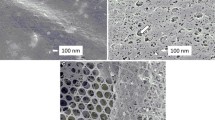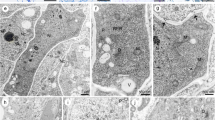Summary
The development of the peridium ofPerichaena vermicularis has been examined using light and electron microscopy and acid phosphatase localization. A newly formed fruiting body consists of undifferentiated protoplasm which is enveloped by a slime coat. Almost immediately after formation of the plasmodiocarp, the protoplasm differentiates into autolytic and fruiting regions. The autolytic region is located at irregular intervals between the slime coat and the fruiting region and separated from both of them by membranes.
Soon after the autolytic region has formed, additional signs of degeneration appear in the autolytic region including unusual appearance of nuclei, increase in autophagic vacuoles, and the presence of clear areas in the ground substance. The plasma membrane, which once completely separated the slime coat from the autolytic region, is no longer continuous. Electron micrographs of the autolytic region from later developmental stages show formation of extensive channels which contain protoplasm in various stages of degradation. Acid phosphatase is present in the channels of the autolytic region. The morphological evidence and the presence of hydrolytic enzyme suggest the region is being digested and re-adsorbed.
After the autolytic region has been digested, an even layer of peridial wall material is laid down, and at regular intervals additional wall material is produced. The additional wall material forms the reticulation on the inside of the peridial wall.
Similar content being viewed by others
References
Aldrich, H. C., 1967: The ultrastructure of meiosis in three species ofPhysarum. Mycologia59, 127–148.
—, andG. Carroll, 1971: Synaptonemal complexes and meiosis inDidymium iridis: A reinvestigation. Mycologia63, 308–316.
Bowers, B., andE. D. Korn, 1969: The fine structure ofAcanthamoeba castellanii (Neff strain). II. Encystment. J. Cell Biol.41, 786–805.
Bracker, C. E., 1968: The ultrastructure and development of sporangia inGilbertella persicaria. Mycologia60, 1016–1067.
Cadman, E. J., 1931: The life history and cytology ofDidymium nigripes. Trans. Roy. Soc. Edinburgh57, pt. 1, 93–142.
Charvat, I., I. K. Ross, andJ. Cronshaw, 1973: Ultrastructure of the plasmodial slime moldPerichaena vermicularis. I. Plasmodium. Protoplasma76, 333–351.
Chet, I., andH. P. Rusch, 1969: Induction of spherule formation inPhysarum polycephalum, J. Bact.100, 673–678.
Daniel, J. W., andU. Järlfors, 1972: Plasmodial ultrastructure of the myxomycetePhysarum polycephalum. Tissue and Cell4, 15–36.
DeDuve, C., andR. Wattiaux, 1966: Functions of lysosomes. Ann. Rev. Physiol.28, 435–492.
Ericsson, J. L. E., 1969: Mechanism of cellular autophagy. In: Lysosomes in biology and pathology. Vol. 2. (J. T. DingleandH. B. Fell, eds.), pp. 345–394. Amsterdam-London: North-Holland Publishing Co.
Goodman, E. M., andH. P. Rusch, 1969: Glycogen inPhysarum polycephalum. Experientia25, 580.
— —, 1970: Ultrastructural changes during spherule formation inPhysarum polycephalum. J. Ultrastruct. Res.30, 172–183.
Gray, W. D., andC. J. Alexopoulos, 1968: Biology of the Myxomycetes. New York: Ronald Press Company.
Guttes, E., S. Guttes, andH. P. Rusch, 1961: Morphological observations on growth and differentiation ofPhysarum polycephalum grown in pure culture. Develop. Biol.3, 588–614.
Hüttermann, A., 1972: Isoenzyme pattern andde novo synthesis of phosphodiesterase during differentiation (spherulation) inPhysarum polycephalum. Arch. Mikrobiol.83, 155–164.
—, andI. Chet, 1971: Activity of some enzymes inPhysarum polycephalum. III. During spherulation (differentiation) induced by mannitol. Arch. Mikrobiol.78, 189–192.
—,M. T. Porter, andH. P. Rusch, 1970: Activity of some enzymes inPhysarum polycephalum. II. During spherulation (differentiation). Arch. Mikrobiol.74, 283–291.
Jahn, E., 1911: Myxomycetenstudien, 8. Ber. dtsch. bot. Ges.29, 231.
Krantzlin, H., 1907: Die Entwicklungsgeschichte der Sporangien bei den Trichien und Arcyrien. Archiv. Protistenk.9, 170–194.
Lister, A., 1893: On the division of nuclei in the Mycetozoa. J. Linn. Soc. (Bot.)29, 529–542.
Matile, P., 1969: Plant lysosomes. In: Lysosomes in biology and pathology (J. T. Dingle andH. B. Fell, eds.), pp. 406–430. Amsterdam-London: North-Holland Publishing Co.
—, 1971: Vacuoles, lysosomes ofNeurospora. Cytobiologie3, 324–330.
—, andA. Wiemken, 1967: The vacuole as the lysosome of the yeast cell. Arch. für Mikrobiol.56, 148–155.
McCormick, J. J., J. C. Blomquist, andH. P. Rusch, 1970: Isolation and characterization of a galactosamine wall from spores and spherules ofPhysarum polycephalum. J. Bact.104, 1119–1125.
Mims, C. W., 1969: Capillitial formation inArcyria cinerea. Mycologia61, 784–798.
—, 1973: A light and electron microscopic study of sporulation in the myxomyceteStemonitis virginiensis. Protoplasma77, 35–54.
Robinson, M., and H. C.Aldrich, 1972: Personal communication.
Ross, I. K., 1957: Capillitial formation in theStemonitaceae. Mycologia49, 809–819.
—, 1967: Growth and development of the myxomycetePerichaena vermicularis.II. Chromosome numbers and nuclear cycles. Amer. J. Bot.54, 1231–1236.
—, 1973: TheStemonitomycetidae, a new subclass of Myxomycete. Mycologia65, 477–485.
Sato, T., 1968: A modified method for lead staining of thin sections. J. Electron Microscopy17, 158–159.
Schuster, F. L., 1969: Nuclear degeneration during spore formation in the true slime mold,Didymium nigripes. J. Ultrastruct. Res.29, 171–181.
Thornton, R. M., 1968: The fine structure ofPhycomyces. I. Autophagic vesicles. J. Ultrastruct. Res.21, 269–280.
Trinci, A. P. J., andR. C. Righelato, 1970: Changes in constituents and ultrastructure of hyphal compartments during autolysis of glucose-starvedPenicillium chrysogenum. J. Gen. Microbiol.60, 239–249.
Wilson, M., andE. J. Cadman, 1928: The life-history and cytology ofReticularis lycoperdon. Trans. Roy. Soc. Edin.55, pt. 3, 555–608.
Author information
Authors and Affiliations
Additional information
This work was supported by National Sciences Foundation grants (GB-5883 and GB-8537) to Dr.Ian K.Ross and an NSF Traineeship (GZ 445 and 796) to I.Charvat.
This constitutes a portion of a thesis presented to the Regents of the University of California by the first author in partial fulfillment of the requirements for the Ph. D. degree.
Rights and permissions
About this article
Cite this article
Charvat, I., Ross, I.K. & Cronshaw, J. Ultrastructure of the plasmodial slime moldPerichaena vermicularis . Protoplasma 78, 1–19 (1973). https://doi.org/10.1007/BF01281519
Received:
Revised:
Issue Date:
DOI: https://doi.org/10.1007/BF01281519




